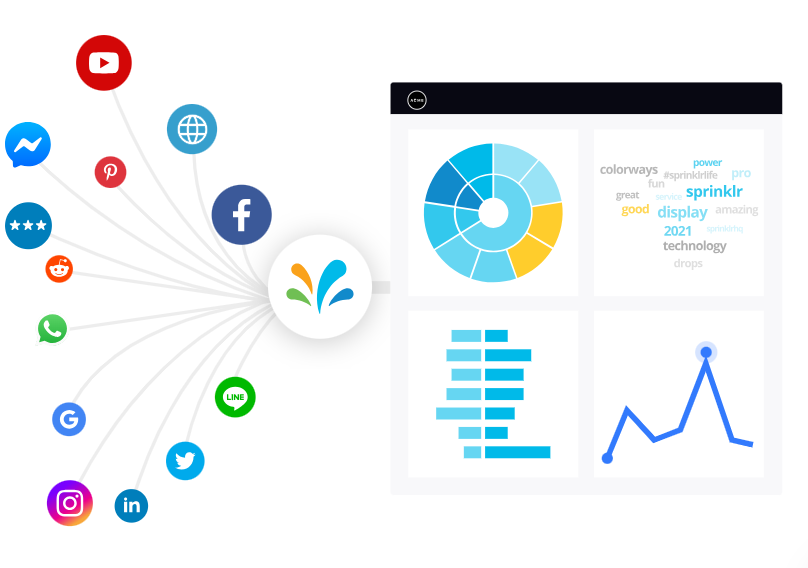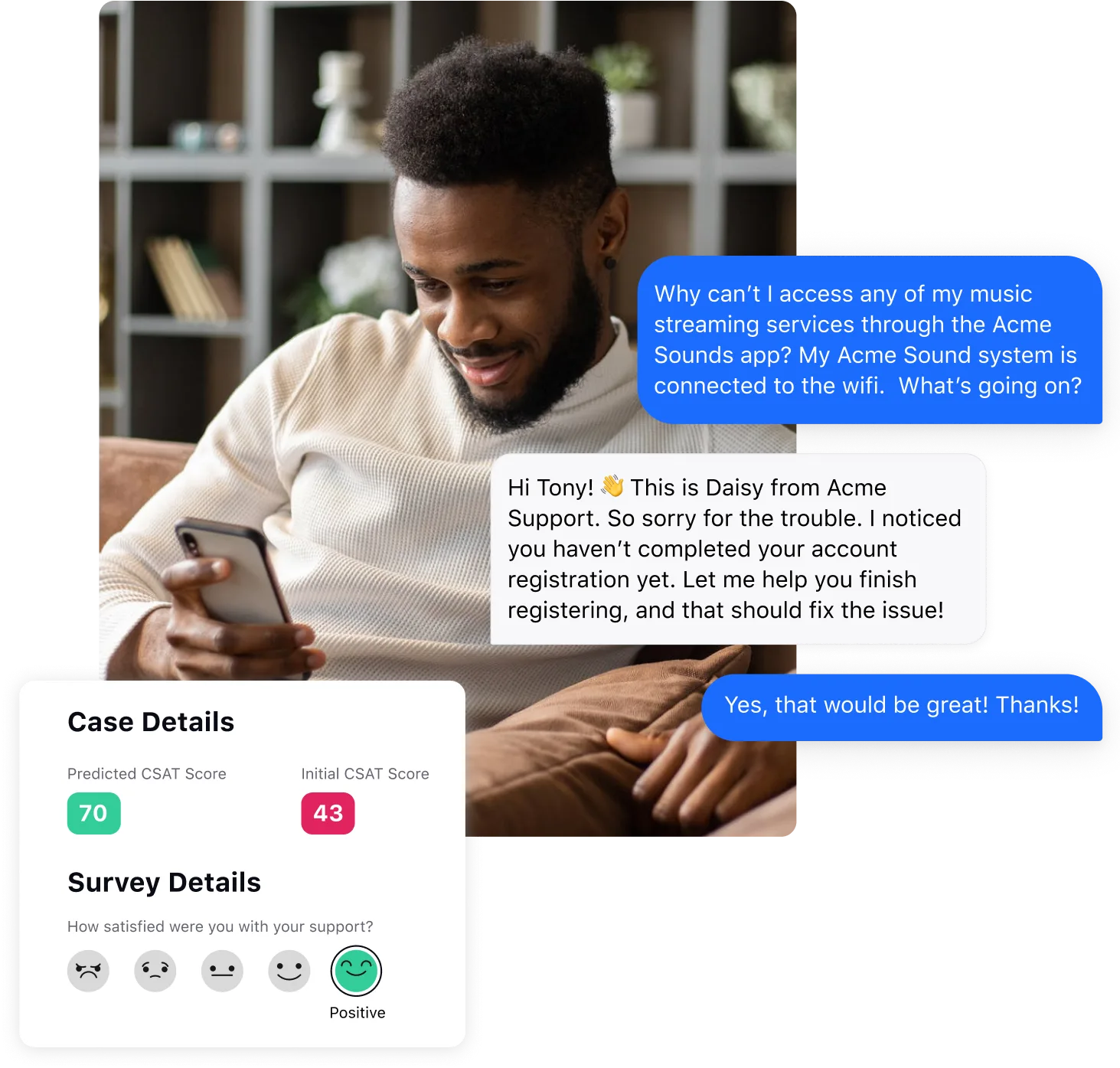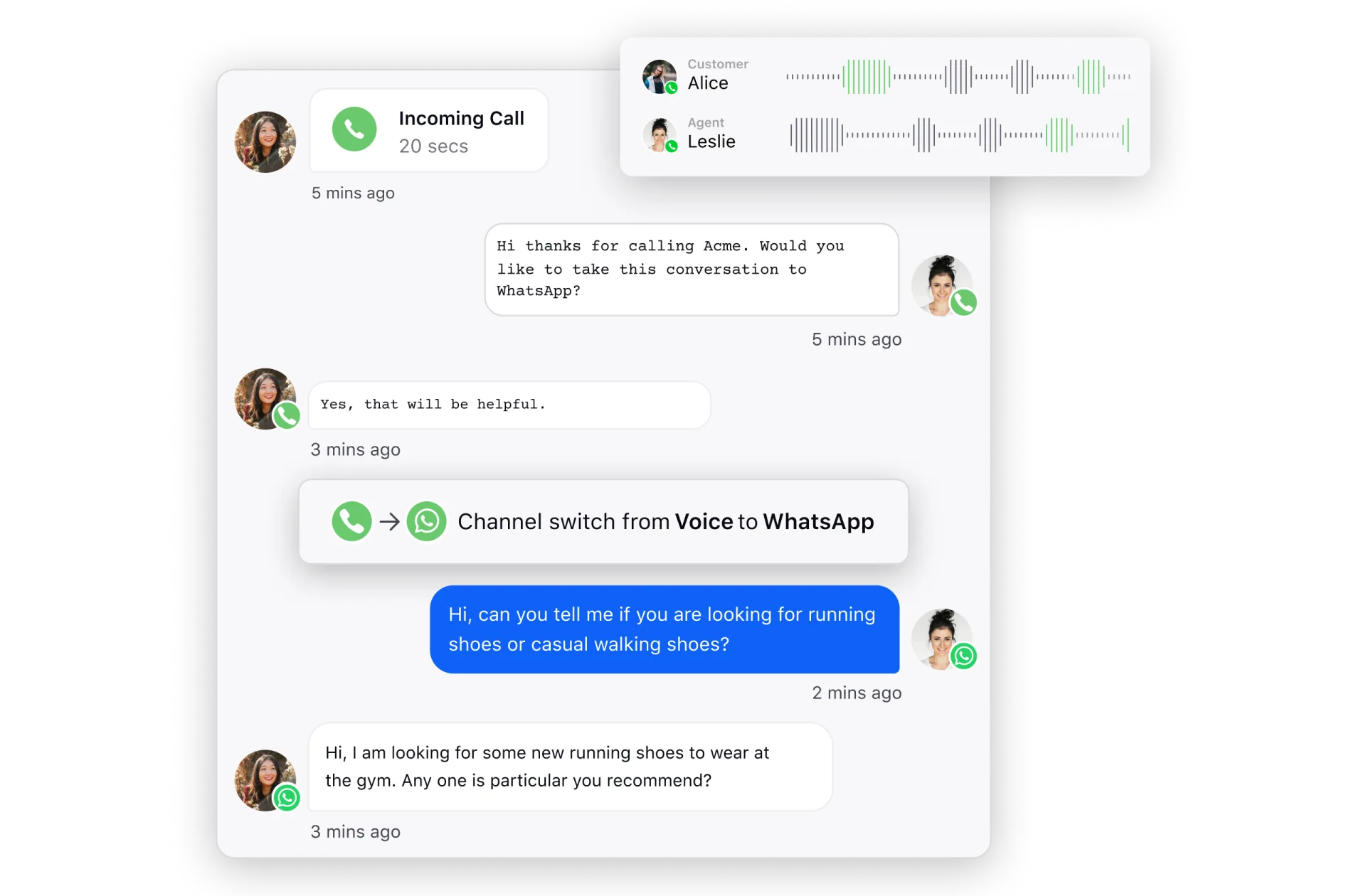What is a contact center?
A contact center is a specialized department within a company that handles customer interactions on various platforms. It can be on-premises or in-cloud; in-house or outsourced; inbound, outbound or hybrid, depending on organizational goals, infrastructure and resources.
Contact centers are set up to deliver timely and personalized customer service on all communication channels by resolving customer queries, troubleshooting issues and keeping customers engaged with the brand. They aim to improve customer satisfaction and customer retention by being accessible and available to customers, no matter what channel they choose for interaction. The job description of a contact center typically includes:
Offering information on various topics
Answering customer questions
Giving personalized shopping suggestions
Gathering customer information
Analyzing customer service metrics
Soliciting customer feedback
To do their job well, contact centers leverage technologies – such as call routing, customer self-service, customer surveys and analytics – that work in unison to deliver a harmonious experience that delights customers, prospects and leads alike and keeps them loyal to the brand.
Contact center vs. Call center
Understanding the nuances between a contact center and a call center is crucial for businesses looking to enhance customer engagement. While both are essential for managing customer interactions, they differ in scope and functionality. Here, we compare key aspects of contact centers and call centers to help you determine which aligns best with your business needs.
Criteria | Contact Center | Call Center |
Communication Channels | Multiple channels | Primarily calls |
Scope of Interactions | Broader range | Voice interactions |
Approach to Customer Service | Comprehensive | Efficiency focused |
Use of Technology | Diverse technology | Phone system focused |
Flexibility | Flexible engagement | Limited communication options |
Overall Focus | Customer experience | Call efficiency |
Dig deeper: Contact Center vs. Call Center: Core Differences
Top 5 benefits of contact centers
Stellar customer service is a failproof way to ensure customer loyalty and repeat sales. These are just two of the ways contact centers can benefit your business. Let’s discuss the other benefits in detail.
1. Consistent brand experiences
The modern customer expects consistency when they engage with brands on different platforms. They don’t want to be repeating their information and past interactions every time. Contact center software has visibility into cross-platform conversations, and your support teams have complete context on each case when handed to them.

2. Improved customer satisfaction
As explained, quick contextual responses go a long way in winning customer trust and loyalty. When customers feel heard and valued, their customer satisfaction (CSAT) shoots up, which keeps them coming back to the business.

3. Better sales, more revenue
Contact centers leverage AI to detect sales readiness in a marketing-qualified lead (MQL) using predefined criteria like CSAT and net promoter score (NPS). Sometimes, it listens in on conversations amidst its target audience and picks up sales signals proactively.
4. Deep customer insights
Contact center analytics collates insights about customers, their needs, interests and challenges in real time. Deep customer insights like this fuel everything from customer support to sales campaigns, enabling you to become your customers’ preferred brand.
Suggested Article: Contact center CRM: A Detailed Guide
5. Reduced support costs
With all your customer data in one place, your agents spend their productive time on query resolution rather than information gathering. Your average handle time (AHT) and first contact resolution (FCR) come down. Agent productivity improves, reducing churn and the subsequent hiring and training costs. Lastly, contact centers are able to deflect costly voice calls to cost-effective channels like email, WhatsApp and live chat, impacting your ROI positively.

💡Pro Tip: To get the most bang for your buck, consider cloud contact centers that come out cheaper than on-premises solutions. They are able to scale rapidly as your business grows without compromising uptime and support speed.
Evolution of contact centers
The evolution of contact centers traces back to the need for businesses to manage customer interactions efficiently. Initially, contact centers primarily focused on handling inbound and outbound calls. However, with technological advancements and changing customer expectations, contact centers have evolved significantly.
Below is a decade-wise evolution of contact centers from the 1960s to the 2020s.
📞Origins (1960s-1970s)
Contact centers emerged as centralized units for handling customer inquiries and support primarily via phone calls.
📱Expansion of channels (1980s-1990s)
Contact centers expanded to include additional channels such as email, chat, and social media, reflecting the growing diversity of customer preferences.
😀Focus on customer experience (2000s)
Contact centers shifted their focus towards delivering exceptional customer experiences, recognizing the impact of service quality on customer satisfaction and loyalty.
🔁Technology integration (2010s)
The integration of advanced technologies such as automation, AI, and analytics became prevalent, enabling contact centers to enhance efficiency, personalization, and decision-making.
📲Shift to CCaaS (2010s-2020s)
The emergence of Contact Center as a Service (CCaaS) solutions revolutionized the industry, offering cloud-based platforms that provide scalability, flexibility, and advanced features to meet evolving customer needs and market dynamics.
💡Wise Words: If you truly want to delight your customers, leverage the contact center as a service (CCaaS) platform.
There are no infrastructure and maintenance costs associated with a physical contact center because your operations live in the cloud.
The cloud service provider is responsible for setting up, upgrading and maintaining all the hardware, liveware and software in the contact center, allowing you to focus on strategic decision-making to power business growth.
11 Types of contact centers
Below are different contact center types grouped together based on a few important aspects of contact center operations:
I. Based on call/ticket flow direction
Inbound contact center
Inbound contact centers are deployed to handle customer-initiated or “inbound” support conversations across your brand’s active channels.
Outbound contact center
Outbound contact centers are majorly used in two scenarios — one, when there is a need for customer service communications that are initiated from your company, and two, when there is a need for outgoing sales communications to promote your products/services.
Blended contact center
As the name suggests, blended contact centers combine both the functionalities of inbound and outbound centers to provide a unified platform for all customer communications.
II. Based on hosting
On-premise contact center
If all of your contact center infrastructure (including technology and workforce) is deployed within the premises of your company, it is referred to as an on-premise contact center.
Hosted contact center
Hosted contact centers are basically contact centers with infrastructure that is deployed and maintained outside of your company.
III. Based on channel coverage
Multichannel contact center
Multichannel contact centers enable businesses to provide support over an array of customer service channels, mostly independent of each other.
Omnichannel contact center
Being the most prevalent type of contact center in the industry now, an omnichannel contact center has an advantage over most other types because it can collate customer conversations across all your active support channels to provide a unified view of your customer profile.
IV. Based on service location
Domestic contact center
Domestic contact centers are widely used by regional businesses or the ones that operate within a specific territory to cater to the local customers in that region.
International contact center
As the name suggests, international contact centers are used by businesses that need to cater to customers all around the world.
V. Other types of contact centers
Apart from these major categories, a few modes of contact center operations are less popular but are used in specific industries and use cases.
Industry-specific contact center
A conglomerate operating across several industries can choose to have separate contact centers for each, in a concept termed an industry-specific contact center.
Virtual contact center
Virtual contact center refer to the style of operations where most or all agents are working remotely from different locations, collaborating over a common contact center solution. Even though they provide the ease of working from anywhere, virtual contact centers tend to create a discontinuous experience for the agents if they are not planned and deployed well.
Curious to learn more? Read Types of Contact Centers
When are contact centers a good choice for businesses?
Contact centers are the future of customer service. They are here to stay. Contrary to popular opinion, enterprises or large-format global brands are not the only ones that can afford contact centers. Companies of all shapes and sizes can embrace the contact center format and delight their customers, stakeholders and teams with stellar customer support that’s also light on the pocket and quick on its toes.
Here are a few scenarios where a company should switch to a contact center as early as possible or risk losing their hard-earned customers to more savvy competitors.
📲Scenario I. Multichannel customer support
If your business receives customer communications from many disparate channels like phone calls, emails, messaging platforms, social media and review platforms, you need a contact center to centralize all these disjointed conversations and weave support experiences that are consistent and speedy.
Migration roadmap
Assess your communication channels
Pick a contact center solution that serves all of these channels
Train or hire blended agents conversant with cross-channel support
Build omnichannel workflows to ingest tickets seamlessly
📈Scenario II. Fluctuating customer demand
A business that experiences seasonal spikes and dips in customer demand can benefit from deploying a contact center for support. It can scale up and down as needed to prevent under- or overstaffing any time of the year. Migration roadmap
Identify the periods of high and low demand
Select a solution with efficient workforce management (WFM)
Build strategies for on- and offboarding seasonal agents
💱Scenario III. Global expansionary plans
If you have designs to expand your operations to international locations, a contact center best suits your needs. Many of these solutions are remote-friendly, drawing from an international resource pool so you can cater to customers from many languages and cultures.
Migration roadmap
Identify your target regions
Choose a solution that supports multiple languages
Develop SOPs and training assets in all your languages
Ensure your customer self-service tools like chatbots and knowledge base are language-agnostic
In addition, if proactive customer engagement and data-driven decision-making are a priority for your business, the contact center is the route. You can start with an on-prem solution and then scale to a cloud contact center as your needs expand.
To implement a contact center for your business, here’s a tentative roadmap to follow stepwise:
Step 1: Assessment:
Analyze your customer communication challenges and challenges. Plus, look into the organizational goals that you aspire to attain with your contact center. Your analytics and contact center metrics will stem from this step.
Step 2: Platform selection
Which platforms do you need to prioritize in your customer service strategy? You will arrive at this answer by tuning in on the platforms, your customers, prospects and leads frequently. Keep an eye on the platform list while vetting contact center solutions.
Step 3: Integration
Using different point solutions for different support aspects can lead to chaos for teams and customers alike. So ensure your chosen contact center software integrates with external tools for helpdesk, ticketing, call center scheduling, customer self-service and other activities.
Step 4: Workflow design
Define your customer journeys, perform customer segmentation and complaint management. After that, set workflows for how tickets flow into your contact center and through the system.
Step 5: Pilot phase
Test your contact center strategy on a small sample group of customers closest to your target group. Define the objectives and watch how your workflows perform against them. Document all your observations, including relevant metrics like CSAT, NPS and customer effort score (CES).
Step 6: Scaling up
From the pilot group, scale to your actual group, adding one region and channel at a time. Solicit feedback from the group using customer surveys and interviews and use it to optimize your contact center operations and performance.
Use cases of contact centers for various industries
Contact centers need to be a part of your business in 2024. What is a business if not for its customers? From handling inquiries and providing support to automating processes and gaining valuable insights, contact centers are pivotal in enhancing customer experiences and driving operational efficiency.
In this section, let’s understand how different industries use contact centers and how an e-commerce company increased its CSAT score by an impressive 15%.
#1. Business Process Outsourcing (BPO)
In BPO operations, contact centers manage phone support, using call center software to scale rapidly, reduce costs, access global talent, and offer competitive pricing.
#2. Healthcare and Telemedicine
Contact centers in healthcare automate appointment reminders, prescription notifications and follow-up calls, enhancing patient adherence and health outcomes through telemedicine services.
#3 Banking and Financial Services
Contact centers in banking offer exceptional customer service, equipping agents with comprehensive customer profiles, ensuring 24/7 support, providing personalized financial advice, and ensuring compliance with regulations.
#4 Restaurants and Food Services
Contact center software enhances customer engagement in restaurants by storing customer data, offering personalized services, addressing feedback and complaints, and improving the overall dining experience.
#5 Travel and Transportation
Contact centers efficiently handle booking inquiries, reservation management, and travel issue resolution, ensuring swift solutions and enhancing customer satisfaction.
#6. E-commerce
Let's use an example for understanding ecommerce conversational AI.
Cdiscount is a leading French e-commerce company with more than 10 million customers and over 13,000 sellers. They wanted to understand how customers experience their brand and what they can do to create better experiences.
The challenge
The call volume was high, and there were multiple communication channels. Reviewing conversations manually was not scalable.
The solution
The company deployed Sprinklr Service to analyze 100% of its customer support conversations. With better analysis of conversations, Cdiscount identified important themes and trends on how to engage and support their customers.
The result
Cdiscount analyzed more than 200,000 hours' worth of calls and more than 75,000 conversations. Agents now receive a quality score for each interaction, which has improved the CSAT score by 15%. Read the full story!
Well, if you are an organization dealing with dissatisfied customers, Sprinklr Service could be the much-needed tool you are missing in your arsenal. If your intentions are noble and you want to make life easier for your customers, we are there for you.
Frequently Asked Questions
related products
Thank you for contacting us.
A Sprinklr representative will be in touch with you shortly.
Contact us today, and we'll create a customized proposal that addresses your unique business needs.
Request a Demo
Welcome Back,
No need to fill out any forms — you're all set.


